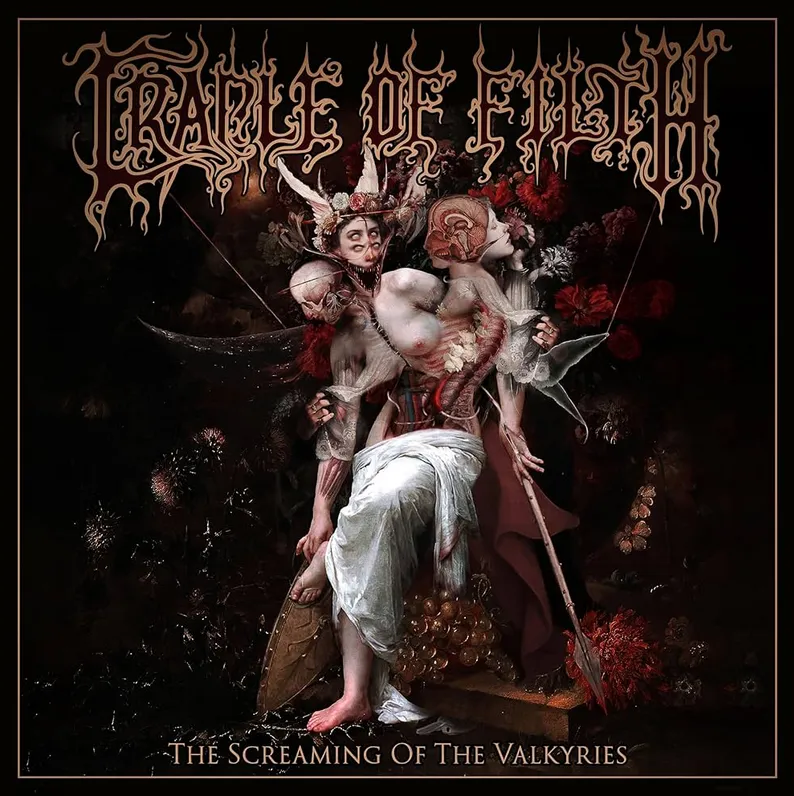The Screaming Of The Valkyries - Cradle Of Filth | Album Review

Overview
| Band | Cradle of Filth |
|---|---|
| Origin | UK |
| Genre | Extreme Metal |
| Release Date | March 21st, 2025 |
| Label | Napalm |
Personnel
- Dani Filth - lead vocals
- Marek "Ashok" Šmerda - guitar
- Donny Burbage - guitar
- Martin "Marthus" Škaroupka - drums, keyboards, orchestrations
- Zoe Marie Federoff - female vocals, keyboards
- Daniel Firth - bass
Review
Version en Español
Ha pasado un tiempo desde la última vez que me sumergí en el mundo de Cradle of Filth. En mis días de secundaria a principios de los 2000, álbumes como From The Cradle To Enslave y Nymphetamine eran fundamentales. Se forjaron un nicho único en el metal extremo, a menudo asociados con el movimiento black metal – una etiqueta que el líder Dani Filth famosamente resistió, prefiriendo el término más amplio "heavy metal" y criticando las interminables clasificaciones de subgéneros.
Cradle of Filth siempre ha coqueteado con el lado más oscuro y siniestro de la escena del metal extremo. Sin embargo, al tejer elementos sinfónicos y góticos en su sonido, han atraído a una base de fans diversa. Los inconfundibles chillidos y gritos de Dani, particularmente sus falsetes altos al estilo King Diamond, son una firma de la banda, amplificando la atmósfera horrible y ominosa de su música. Son mucho más que una simple banda de metal extremo.
Desde aquellos primeros días, Cradle of Filth ha lanzado más de diez álbumes que no había tenido la oportunidad de explorar. Por lo tanto, escuchar su última entrega, The Screaming Of The Valkyries, se siente como redescubrir un viejo refugio y ver cómo ha evolucionado. Una búsqueda rápida reveló que este es el primer álbum con dos nuevos miembros: Donny Burbage en las guitarras y Zoe Marie Federoff en teclados y voces femeninas. Esto despertó inmediatamente mi interés, ya que las voces femeninas no eran una característica que recordara de sus trabajos anteriores. ¿Estuvo el álbum a la altura de mis reavivadas expectativas? Sumerjámonos en el análisis pista por pista.
Pista por Pista
El álbum arranca con el primer sencillo, "To Live Deliciously." Es una pista vertiginosa y rápida al estilo clásico de Filth, respaldada por texturas sinfónicas de teclado. Elementos del black metal como los blast beats y las armonías de guitarra características están presentes, pero también hay una fuerte mezcla de batería de thrash metal y componentes clásicos de heavy metal, especialmente notables en los solos de guitarra.
A continuación viene "Demagoguery," acertadamente nombrada por la práctica política de buscar apoyo a través de apelaciones a la emoción en lugar de argumentos racionales – ¿quizás una crítica a la política moderna? La canción se inclina hacia una sensación más oscura y gótica, con capas prominentes de teclado. Si bien la entrega vocal de Dani se siente ligeramente monótona aquí, el estilo clásico de Cradle of Filth permanece, puntuado por cambios de tempo hacia el final que traen de vuelta la sensación de la batería thrash.
"The Trinity of Shadows" sigue y se destaca como una de las favoritas tempranas. Cuenta con un increíble riff introductorio e incorpora una variedad de ideas de hard rock y metal que se sienten frescas en comparación con mis recuerdos de su material más antiguo.
Luego llegamos a "Non Omnis Moriar," que regresa a un paisaje sonoro clásico de metal gótico dominado por teclados y los oscuros gritos guturales de Dani. Esta pista marca la primera contribución vocal principal significativa de Zoe Marie Federoff. Su voz proporciona un contraste convincente, aunque podría decirse que la canción pierde algo de dinamismo hacia su conclusión.
"White Hellebore," el segundo sencillo, presenta otra aparición prominente de Zoe Marie, esta vez en una canción de ritmo más rápido. Alrededor de la mitad, emergen elementos sinfónicos que recuerdan a bandas como Epica. Si bien no es una pista destacada en general, tiene sus momentos atractivos.
Continuando a través del álbum, "You Are My Nautilus" es la pieza más larga. Aquí, las armonías de guitarra me recordaron fuertemente la era de The Sound of Perseverance de Death. A pesar de este guiño, la atmósfera gótica y sinfónica omnipresente arraiga firmemente la pista en el estilo característico de Cradle of Filth.
"Malignant Perfection" adopta un tono más espeluznante y oscuro, sirviendo como una configuración perfecta para otra pieza gótica. Presenta un coro fuerte realzado por voces femeninas de acompañamiento y, una vez más, incorpora blast beats como un claro tributo a sus influencias de black metal.
La penúltima pista, "Ex Sanguine Draculae," se siente como una culminación de los sonidos explorados a lo largo del álbum y, de hecho, a través del extenso catálogo de Cradle of Filth.
Finalmente, "When Misery Was A Stranger" cierra el álbum. Revisa las armonías de guitarra al estilo de Death en una estructura de ritmo más lento antes de estallar en un final extremadamente rápido y pesado.
Pensamientos Finales
Para mí, The Screaming Of The Valkyries sirvió como un bienvenido punto de reingreso al mundo de Cradle of Filth. Mezcla con éxito muchos de los elementos que disfruté de sus primeros trabajos con desarrollos sinfónicos y góticos más nuevos. La composición y las interpretaciones son puntos destacados definitivos, mostrando habilidad técnica y una sólida escritura de canciones.
Sin embargo, en cuanto a originalidad e impacto, el álbum se siente algo menos innovador en comparación con sus lanzamientos clásicos o incluso dentro del contexto más amplio de la escena actual del metal. Si bien está expertamente elaborado, no se aleja mucho del territorio establecido de Cradle of Filth.
En general, es una fuerte adición a su discografía y una escucha satisfactoria para los fans, incluso si no reinventa radicalmente su sonido.
It's been a while since I last delved into the world of Cradle of Filth. Back in my high school days in the early 2000s, albums like From The Cradle To Enslave and Nymphetamine were staples. They carved a unique niche in extreme metal, often associated with the black metal movement – a label frontman Dani Filth famously resisted, preferring the broader term "heavy metal" and criticising the endless subgenre classifications.
Cradle of Filth has always courted the darker, more sinister side of the extreme metal scene. Yet, by weaving symphonic and gothic elements into their sound, they've attracted a diverse fanbase. Dani's unmistakable shrieks and screams, particularly his King Diamond-esque high falsettos, are a band signature, amplifying the horrific and ominous atmosphere of their music. They are far more than just another extreme metal band.
Since those early days, Cradle of Filth has released over ten albums that I haven't had the chance to explore. So, listening to their latest offering, The Screaming Of The Valkyries, feels like rediscovering an old haunt and seeing how it's evolved. A quick search revealed this is the first album featuring two new members: Donny Burbage on guitars and Zoe Marie Federoff on keyboards and female vocals. This immediately piqued my interest, as female vocals weren't a feature I recalled from their earlier work. Did the album live up to my rekindled expectations? Let's dive into the track-by-track.
Track By Track
The album kicks off with the first single, "To Live Deliciously." It's a blistering, fast-paced track in classic Filth style, underpinned by symphonic keyboard textures. Black metal elements like blast beats and characteristic guitar harmonies are present, but there's also a strong mix of thrash metal drumming and classic heavy metal components, especially noticeable in the guitar solos.
Next up is "Demagoguery," aptly named after the political practice of seeking support through appeals to emotion rather than rational argument – perhaps a critique of modern politics? The song leans into a darker, more gothic feel, with prominent keyboard layers. While Dani's vocal delivery feels slightly monotonous here, the classic Cradle of Filth style remains, punctuated by tempo changes towards the end that bring back the thrash drumming feel.
"The Trinity of Shadows" follows and stands out as an early favourite. It boasts an amazing introductory riff and incorporates a variety of hard rock and metal ideas that feel fresh compared to my memories of their older material.
We then reach "Non Omnis Moriar," which returns to a classic gothic metal soundscape dominated by keyboards and Dani's dark, guttural screams. This track marks the first significant lead vocal contribution from Zoe Marie Federoff. Her voice provides a compelling contrast, though the song arguably loses some dynamism towards its conclusion.
"White Hellebore," the second single, features another prominent appearance by Zoe Marie, this time in a faster-paced song. Around the halfway mark, symphonic elements reminiscent of bands like Epica emerge. While not a standout track overall, it has its appealing moments.
Continuing through the album, "You Are My Nautilus" is the longest piece. Here, the guitar harmonies strongly reminded me of Death's The Sound of Perseverance era. Despite this nod, the pervasive gothic and symphonic atmosphere firmly roots the track in Cradle of Filth's signature style.
"Malignant Perfection" adopts a more eerie and dark tone, serving as a perfect setup for another gothic piece. It features a strong chorus enhanced by female backing vocals and, once again, incorporates blast beats as a clear tribute to their black metal influences.
The penultimate track, "Ex Sanguine Draculae," feels like a culmination of the sounds explored throughout the album and, indeed, across Cradle of Filth's extensive catalogue.
Finally, "When Misery Was A Stranger" closes the album. It revisits the Death-style guitar harmonies in a slower-paced structure before erupting into an extremely fast and heavy finale.
Final Thoughts
For me, The Screaming Of The Valkyries served as a welcome re-entry point into the world of Cradle of Filth. It successfully blends many of the elements I enjoyed from their early work with newer symphonic and gothic developments. The composition and performances are definite highlights, showcasing technical skill and strong songwriting.
However, regarding originality and impact, the album feels somewhat less groundbreaking compared to their classic releases or even within the broader context of the current metal scene. While expertly crafted, it doesn't stray far from established Cradle of Filth territory.
Overall, it's a strong addition to their discography and a satisfying listen for fans, even if it doesn't radically reinvent their sound.
Final Scoring
Track List (Spotify Version)
- To Live Deliciously (5:32)
- Demagoguery (6:16)
- The Trinity Of Shadows (6:22)
- Non Omnis Moriar (5:05)
- White Hellebore (5:04)
- You Are My Nautilus (7:39)
- Malignant Perfection (6:45)
- Ex Sanguine Draculae (7:09)
- When Misery Was A Stranger (6:21)
